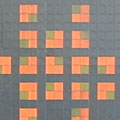







|
|

|
Loops
In this experiment, the visitor turns creator,
causing the development of elementary artificial organismscapable of self-replicating.
By simply pressing any "mother loop" molecule, the visitor
triggers the self-replication process and creates a "daughter
loop".
|
Loops : The magic of self-replication
|
Life is reproduction - this is clearly the difference
between a being and an object.
But "artificial life" specialists have always found studying
computer motifs capable of self-replication to be a major challenge.
In the Loops experiment, the visitor discovers the most basic
self-replicating loops, discovered by American researcher James
Reggia. Simply by pressing any molecule on the loop, he triggers
the automatic self-replication mechanism which generates a "daughter
loop", a true clone of the "mother loop". He can also confirm
that, within a confined space, a mother loop can kill a daughter
loop, but that the reverse is impossible: loops can only cohabit
under very strict hierarchical rules. |
|
Instructions for use
The BioWall displays a number of basic loops in the form of a square comprising four molecules.
|
Inert loop
Without outside intervention, every loop is inert;
it rotates anti-clockwise about its own axis in four stages
(figure 1).

Figure 1: Inert loop rotating in four stages.
|
Loop self-replication
You can try to trigger self-replication by pressing
any one of a loop's four molecules: the molecule immediately
turns red, the self-replication mechanism begins and, if there
are no obstructions, a daughter loop appears to the right of
the mother loop following an 8-stage process. Both loops are
inert, rotating counterclockwise about their own axis (figure
2).

Figure 2: Loop self-replication in eight stages.
|
Loop destruction
This time, the mother loop is in a confined space (figure 3), with a daughter loop on its immediate right. By pressing
any molecule of the mother loop (shown in red), you trigger an 8-stage destructive process, at the end of which the mother loop
kills the daughter loop.

Figure 3: Destruction of a daughter loop by a mother loop in
eight stages.
|
Behind the scenes
The first self-replicating loop was discovered in 1984 by Chris Langton, an American researcher considered to be the
spiritual father of "artificial life". This loop has since been simplified by numerous scientists. The version set out here is the
result of research by James Reggia and, to the best of our knowledge, has the simplest structure of this type of organism.

For further information
- J.A. Reggia, S.L. Armentrout, H.-H. Chou, Y. Peng: Simple systems that exhibit self-directed replication, Science,
Vol. 259, 26 February 1993, pp. 1282-1287.
Resources
|
|
|

